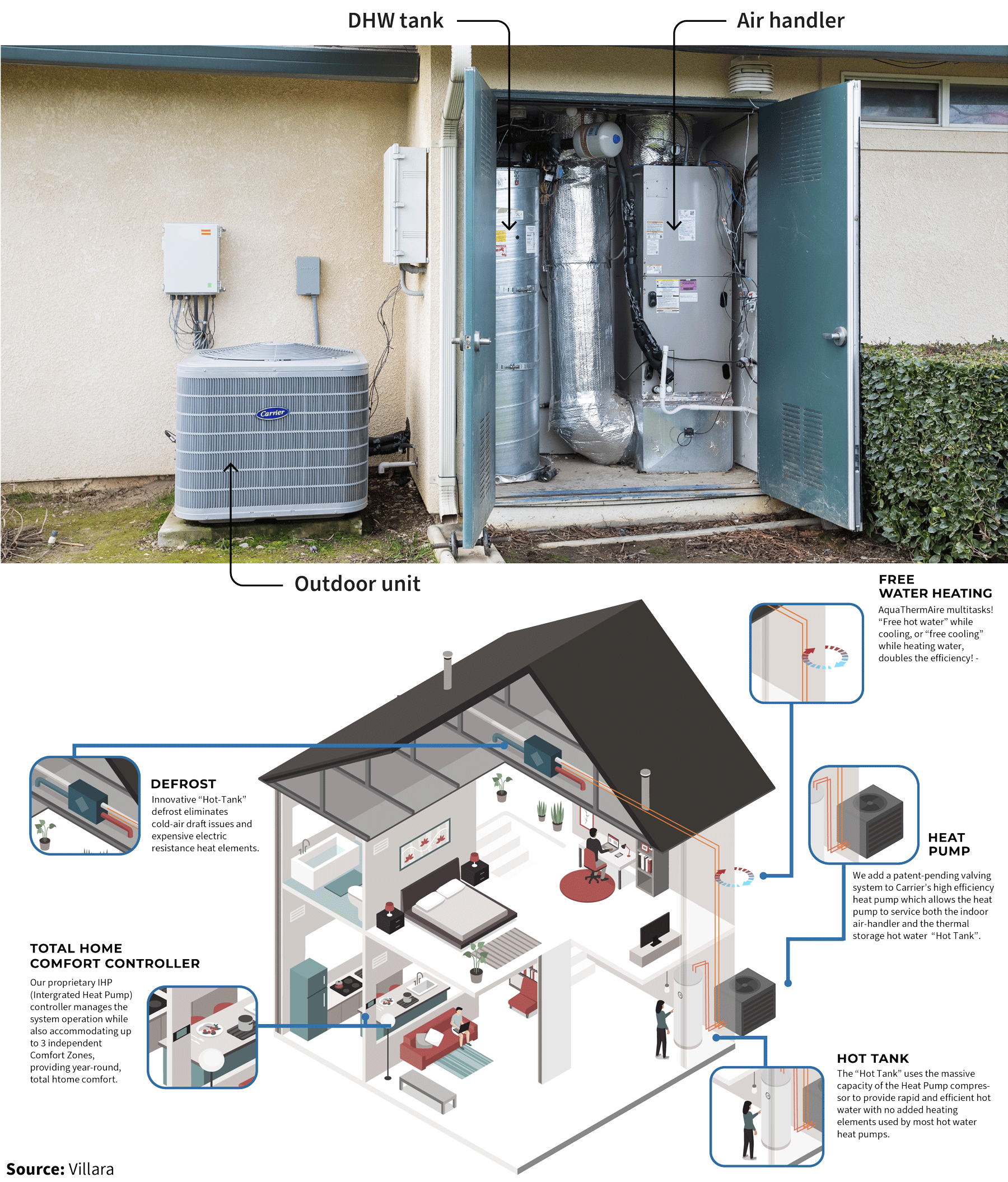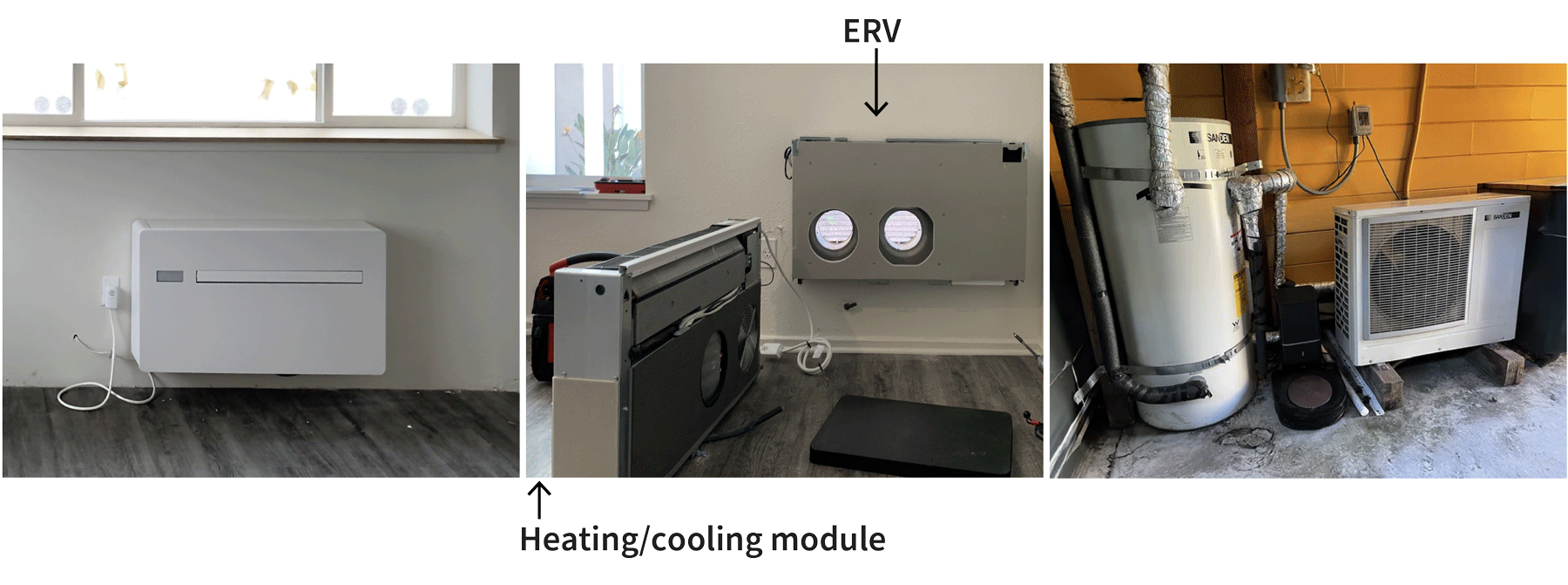
Multifunction Mechanical Systems
Evaluating multifunction heating, cooling, ventilation, and hot water systems in multifamily buildings retrofits.
The Issue
One of the biggest barriers to building decarbonization retrofits to existing homes is the extensive building modifications and rework required to accommodate replacement technologies and systems. This rework is often time-consuming, disruptive, bespoke, and costly. Heating, ventilation, and air conditioning (HVAC) and domestic hot water (DHW) systems can pose additional challenges because the system components are often spread throughout the building. Combining the components that deliver the major mechanical end uses of a home (heating, cooling, ventilation, and hot water) into an efficient ‘retrofit-ready’ package — one that is designed for easy installation with minimal building modifications — could offer advantages over business-as-usual retrofit electrification approaches by streamlining installation and enhancing performance through heat recovery and coordinated controls. This technology brief, funded by the California Energy Commission Electric Program Investment Charge (EPIC) program, presents three distinct approaches to multifunction mechanical systems for multifamily building retrofits, and assesses their benefits, challenges, and suitability for California’s existing multifamily building market.
Overview of the multifunction mechanical systems
The three approaches evaluated in this brief include fully packaged, partially packaged, and distributed, all utilizing low global warming potential (GWP<750) refrigerants.
1. Fully packaged: An all-in-one-box mechanical system that provides heating, cooling, DHW, and energy recovery ventilation (ERV).
The Systemair Genius, which utilizes R32 refrigerant, is an example of a fully packaged multifunction mechanical system with ducted distribution. The system is contained within one large refrigerator-sized enclosure (3’ x 3’ x 7’ tall), and is composed of three modular parts: the base module contains the 40-gallon hot water storage tank and water pump, the electrical components and control board; the middle module contains the heat pump with the compressor, heat exchangers, and refrigerant circuit; and the top module contains the heat recovery ventilator, which is an enthalpy flywheel paired with supply and exhaust fans as shown in Exhibit 1. There is one 40A, 240V electrical connection to the unit, which powers all of the modules in each mode of operation, including a backup electric resistance heater in the DHW tank.
2. Partially packaged: A three-in-one heat pump system that provides heating, cooling, and DHW.
The Villara AquaThermAire (AQTA), which utilizes R454b refrigerant, is an example of a partially packaged multifunction mechanical system. It provides heating, cooling, and DHW with a single compressor. Ventilation can be added either as a separate system or through modifications to the air handler, but does not come standard with the product. The system is comprised of an off-the-shelf air handler, a purpose-built hot water tank, and a single-speed outdoor condenser/compressor unit. It uses a modified refrigerant circuit and proprietary refrigerant management system to enable the single heat pump to serve both the air handler and the hot water tank as shown in Exhibit 2.
The unique hot water tank was designed and manufactured by Villara and has no backup electric resistance heating element or electrical connection. The system can perform heat recovery when operating in simultaneous space cooling and water heating mode, whereby heat captured from cooling is rejected into the DHW tank. The AQTA also has a unique system to manage the heat pump’s defrost cycle, whereby the heat stored in the hot water tank is used to defrost the coil as opposed to the standard method of using the heat from the conditioned air. This facilitates much shorter defrost cycles that are typically only two to three minutes, and more importantly, it prevents the most common complaint associated with defrost: blowing cold air into a heated space.
3. Distributed: A room-by-room multifunction mechanical system with through-wall heat pump equipment that provides space heating, space cooling, and ventilation with heat recovery, and is paired with a separate heat pump water heating system.
The Ephoca All-In-One Wall Mount (AIO WM) + ERV, which utilizes R32 refrigerant, is an example of a distributed package, and can be paired with a central heat pump water heating system (CHPWH) to provide all mechanical end uses. The Ephoca AIO WM+ERV unit is a modular three-in-one packaged terminal heat pump that is installed as a through-wall HVAC system that delivers ductless space heating, space cooling, and energy recovery ventilation as shown in Exhibit 3.
The ERV is a modular component that can be added on to the AIO WM unit where ventilation is desired and utilizes the same exterior penetrations as the space conditioning module. HVAC control schemes can be utilized to coordinate the zonal equipment with each other and other thermal comfort components like ceiling fans. The SanCO2 is an example of a common CHPWH system for multifamily that provides hot water to multiple apartments using an inverter-driven heat pump paired with one or more 119-gallon hot water storage tanks and uses R744 refrigerant. The HVAC and DHW components of this system are not inherently integrated, as the HVAC is room-by-room and the DHW is centralized. This configuration allows for this approach to be used in buildings with both unitary and central DHW systems and can scale to meet a wide range of space conditioning loads by adding more through-wall units. The AIO WM units do require electrical connections, typically on dedicated circuits, and can either be hardwired or plugged into a wall outlet.



The project was generously funded by the California Energy Commission’s EPIC program and was completed in partnership with RMI, Association for Energy Affordability, Emanant Systems, SmithGroup, Lawrence Berkeley National Lab, National CORE, Self Help Enterprises, Ephoca, SystemAir, and Villara Corporation.
